
The purpose of this book is to review the critics on Roy Lichtenstein works through the past 35 years, highlighting the almost unanimous credo in a well- mannered, recognisable artist who had nothing new to say after the first 10 years of his long carrier.
Roy Lichtenstein become almost immediately, with his debut on the American artistic stage into an indisputably easy to remember, easy to recognise and not provocative an artist.
His artistic trajectory from the early 1960’s until his death in the late 1990’s is a one-way stream with mild turns, almost imperceptible to the neophytes, that didn’t affect his position as one of the most important American icon producers of the 20th Century.
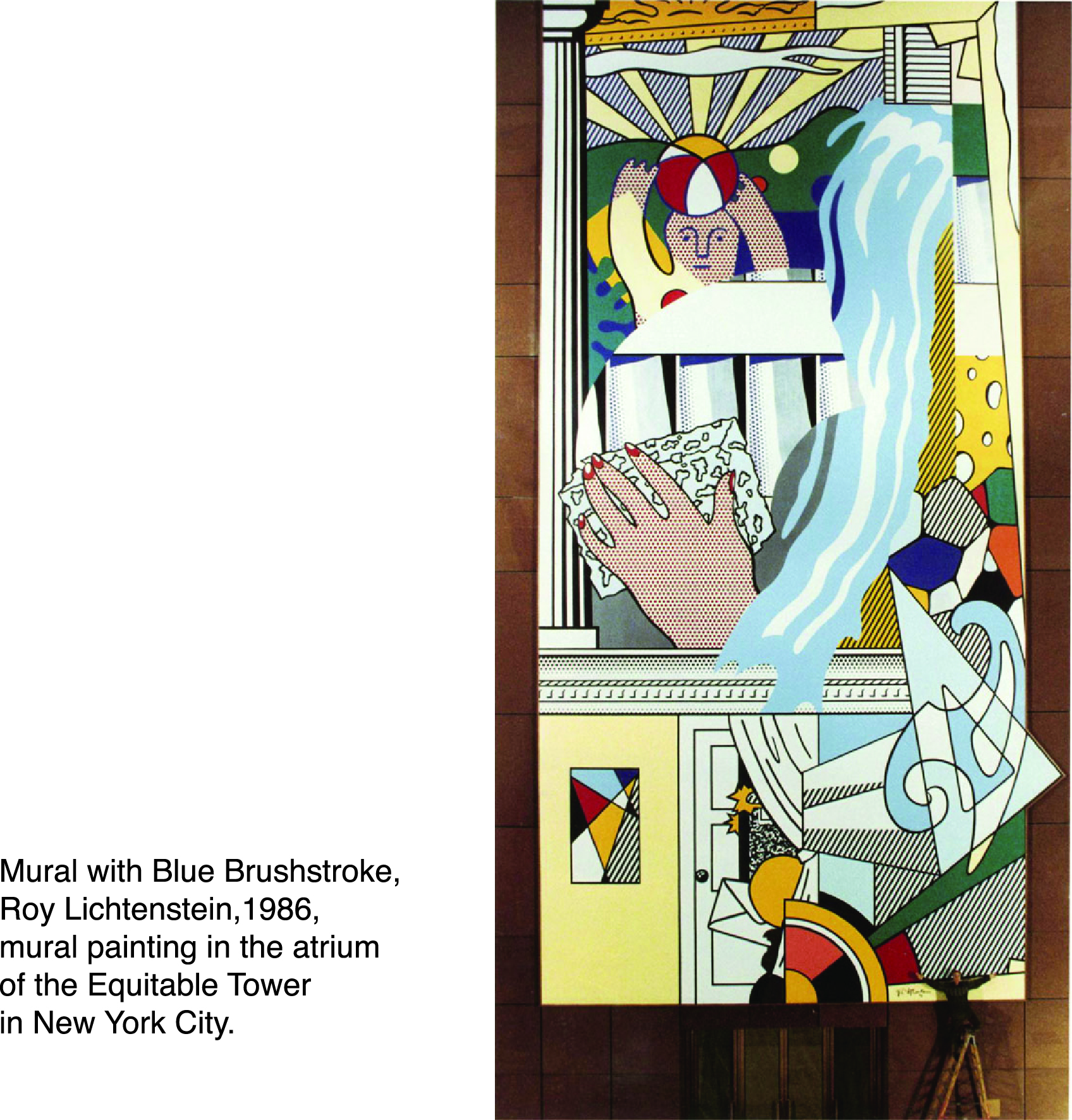
The large (and sometimes huge) one-man exhibitions and retrospectives that Lichtenstein held since the early 1960’s projected a familiar image of flat colors, archetypes of comics and benday dots recognizable and friendly. His public sculpture – Barcelona, Jerusalem – are always a somewhat optimistic milestones in the city. Never has there been a polemic attached to his name nor has it ever inflamed or offended the critic. His works are (and from my point of view, should be) welcomed in big museums, important galleries and private collections. In the 1980’s, his profuse work, always professional, always neat – even if manufactured by others- became deja vu. Being a living star of the first Pop-Art generation he did not deliver any new messages or asked relevant and challenging questions, neither artistically nor socially. And in a Pop-Art world, where Keith Haring is the already venerated dead king of a second generation, Lichtenstein presence became that of an Old Master. . . We admired him, we loved him, but after we got to know him, we didn’t expect anything new from him.

Lichtenstein was an American symbols maker that aroused the question, well before his death, “…so what’s new?” and the answer was always “more of the same”.
Roy Lichtenstein was crowned, since the early 1960’s as “a quite affable man of 40”, “Mister-Nice-Guy” of the Pop-Art, a style placed between a new movement in Contemporary Art and the output of a bunch of near dilettante kitsch makers, depending on your point of view at that time. Some of the Pop Art artists act as a devil’s advocate of art, while some others where too busy using the tricks-of-the trade that worked so nicely
and submerge themselves in a constant and very successful making-money-through-art activity.
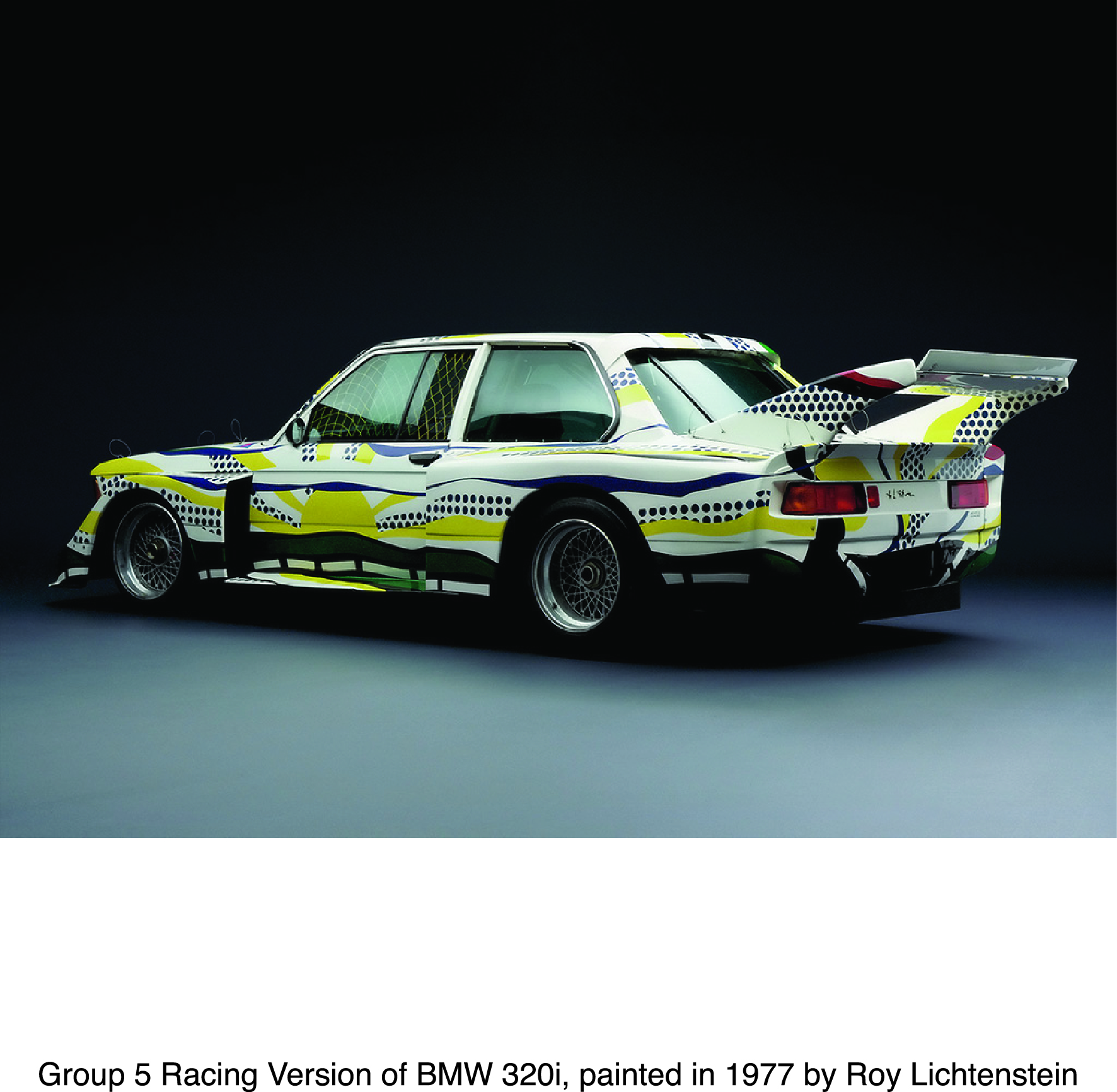
In an American art world, ruled by art critics captured by the magic magnetism of a macho-abstract-novelty as the Abstract Expressionism (or Action Painting if you are on the other side of Greenberg’s sidewalk), Pop Art is controversial, amusing and easy to recognize. This is almost a sin in the academic world, where decoding and interpreting is crucial.
The first great critical reaction to the movement comes from Clement Greenberg. His intention in the early sixties was to paint a picture so ugly nobody would hang it, but this traditional avant-gardist assault on the middle-class collector was doomed to fail; within a few years half the art buyers in America were queuing up to purchase these icons of supposedly bad taste.

Greenberg is going to be defeated by dealers, clients and the public who from the sixties on, have been converting almost every Pop Art, and furthermore, every Lichtenstein exhibition, into a Block-Buster. At the same time that Greenberg wrote his cynical remarks, the first serious collectors of Pop Art appeared in the scene buying and trading their works. More than that…how many people really read or listen to Greenberg’s apocalyptic prophecies about “that style”?
Greenberg is the first of the great art critics of the ’50s and ’60s that attacks Pop Art and its artists in a virulent way, calling the movement “fashion” and “school”. A school which in general “amounts to a new episode in the history of taste, not to an authentically new episode in the evolution of contemporary art”
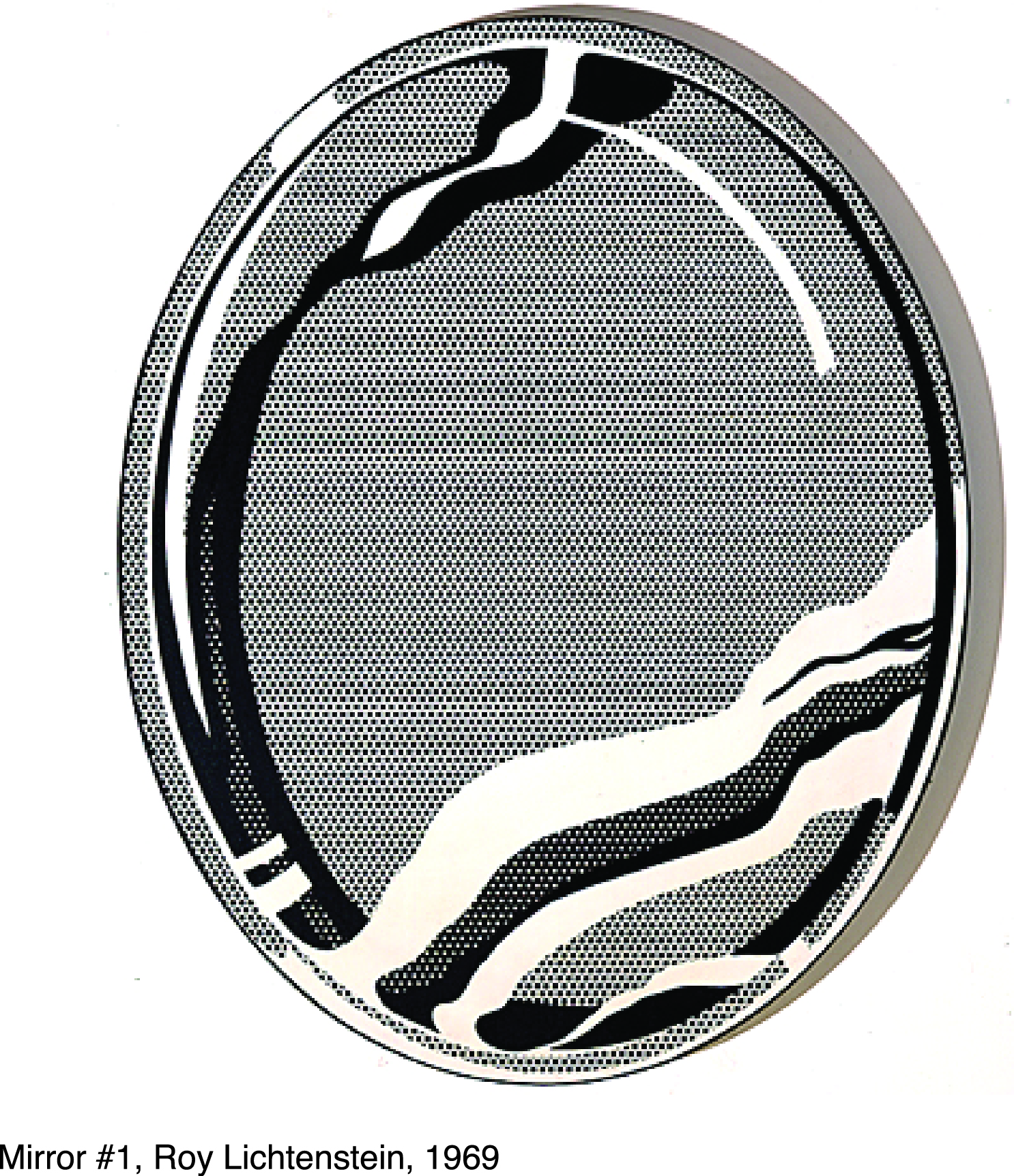
Lichtenstein becomes after his appearance in New York Leo Castelli’s gallery in 1962 a kind of pleasant, previsioned and not annoying figure. His work is easy to relate to, and even easier to analyze and fragment. In the 1970’s his role in the phenomenon of Pop Art is defined by Edward Lucie-Smith as one of the leaders of the movement, but only after Johns and Rauchenberg, knighted by him as “forerunners”.
His super-clean works made him a creator of visual oasis, decorative and familiar that stands against canvases dripped and stripped in a semi-casual manner by the Abstract Expressionism painters.
He had already had one-man-shows in the sixties and kept exposing until his death, with Leo Castelli pushing
one exposition after another during the last three decades of the 20th Century. Since 1962 and until 1998 more than 130 solo exhibitions where held all over the world, 22 of which at Leo Castelli’s art gallery in New York. The eighties is the time when Lichtenstein switches to
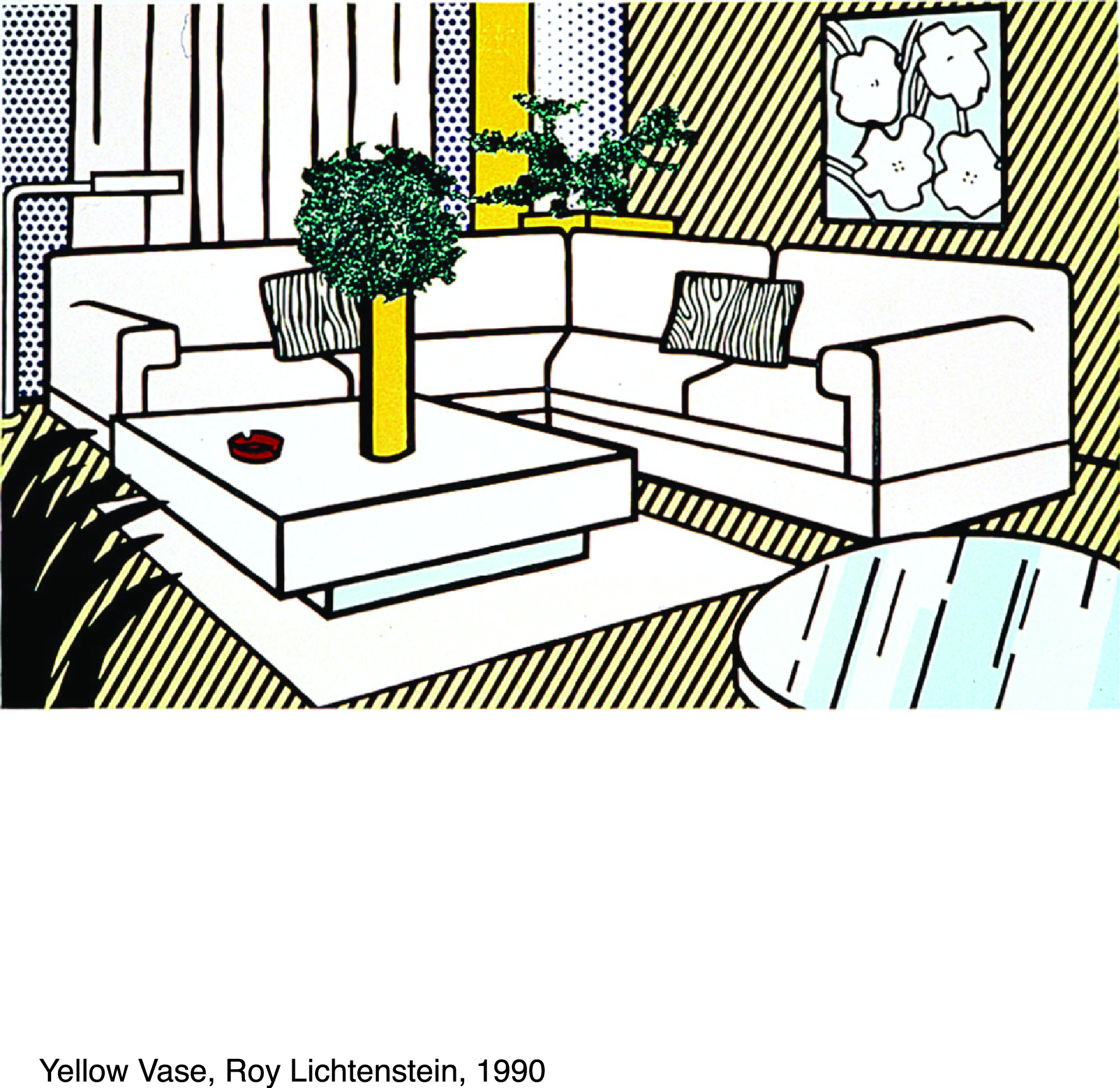
the gigantic wall paintings in buildings, a form of immovable art on murals that nobody can show in an art gallery or a museum. This is why the ’80s are also the time of his great retrospectives where the shows focus in presenting to his public sketches and preparatory drawings, more than actual finished works. The last one of those exhibitions is “Roy Lichtenstein: Interiors” running at the Museum of Contemporary Art Chicago from July 24 until October 10,1999. The exhibition curators Robert Fitzpatrick and Lichtenstein widow Dorothy,
pointed that is he first museum exhibition to focus on the interior as a subject in Lichtenstein’s late works. It looks again like a confirmation that in art you can arrange and rearrange works and every time give them a new interpretation.
In 1988 the Moma organized such an exhibition and Berenice Rose, who wrote the catalogue, divided his works on paper into two major types: sketch and study. A kind of esoteric separation based on quality of line, pushing again the boundaries of the obvious to transform it into something venerable.
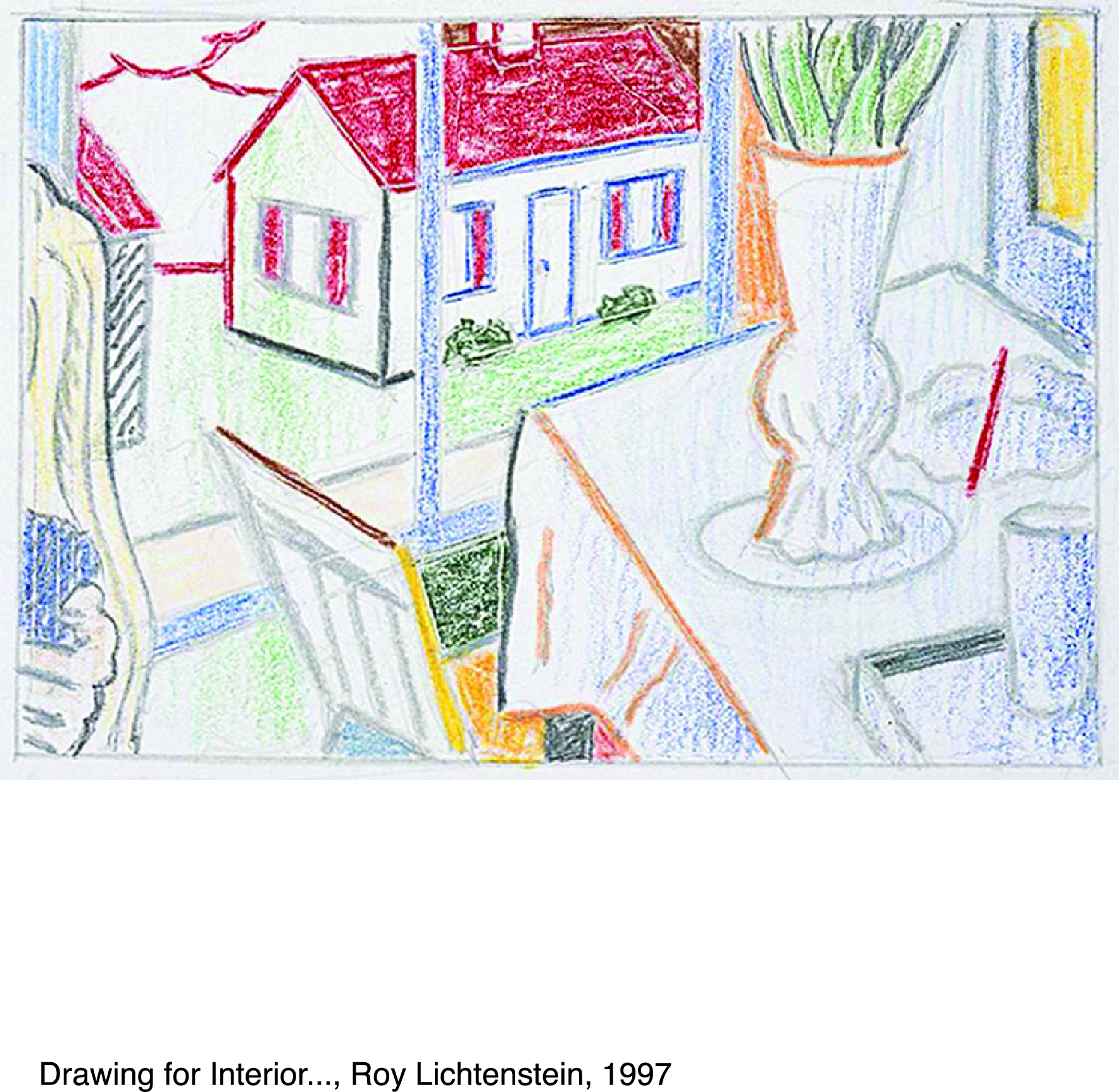
In 1989 Carter Ratcliff wrote with more admiration than annoyance: “A visit to an art city here or abroad will probably turn up a Lichtenstein show in progress or just a few slots away in the schedule of some highly respectable gallery.”
But, alas, nothing new was said. The critics and some historians tried to divide his huge artistic harvest into different time periods. They tried to make him some kind of New Yorker Picasso by presenting his “comics” period of the ’60s, the “mirror paintings” of ’71 to ’73, the mock-surrealist works of the late ’70s and his gigantic murals of the ’80s as if there is a real and strong development in his style, approach or even technique.
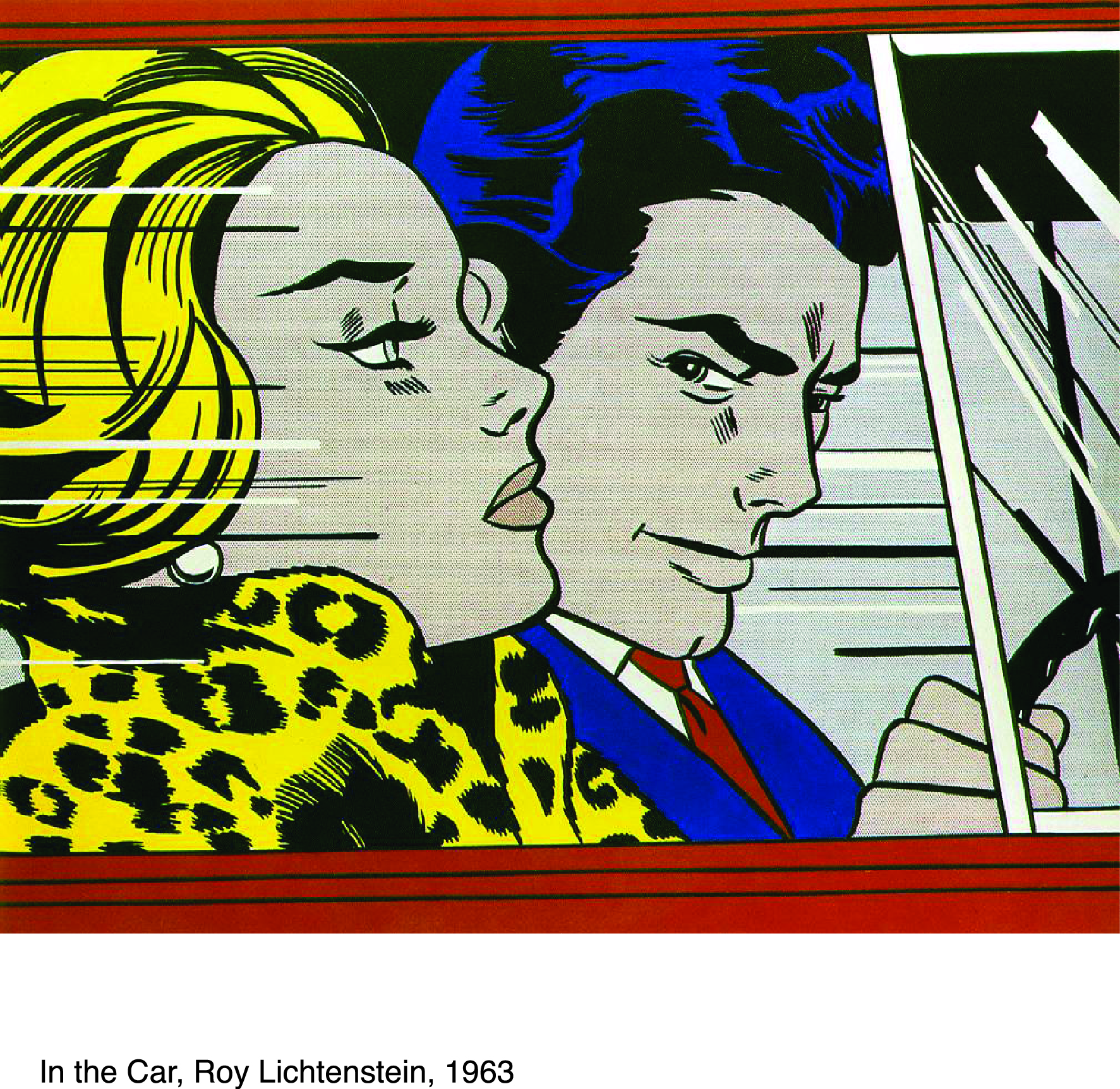
What happened is that his work is previsioned, the blow-up of an ordinary object is no more the ultimate alienation. Oliverio Toscani does it more strongly and much more provocatively with his billboards of
Benetton. The huge photographs of a bare bottom with an H.I.V. positive tattoo in it or a dying cormorant in an oil spill during the Gulf War is relevant (even if suspiciously capitalist and soap operettish). The picture of a gigantic golf ball is not relevant…and never was.
Robert Hughes tries to breathe some evil or critic intentions in Lichtenstein’s works, denominating the artist s series of “Brushstrokes” as “perversely rendered in flat color and Benday dots. It sounds more like a wishful thinking and a bad day for definitions than a reflection of the artist’s real goal. An artist more closed in Ins own world of duplications and recycling who synthesizes his oeuvre quite early in his carrier in Ins painting “What do you know about my Image Duplicator “.

Every one wants “a Lichtenstein” and every art museum feels the duty to hang one, more if he can afford it. Tel Aviv Museum of Art chooses in 1989 to take down an antique Goblin to make room in his atrium walls for an immense diptych by Lichtenstein. In the summer of 1996 no Hockney’s work
was hanged in the London Tate Gallery (today Tate Britain), but Lichtenstein’s aircraft fighter blew up his enemy in a huge canvas there.
The ultra modern Bilbao Guggenheim Museum exhibits a work of him in his opening exhibition in 1997.
And yet, he is already, even 15 years before his death in 1997, a common place, a deja vu deliverer of a predicable kind of esthetic that allows us all to understand what is he painting about, but not always to understand why he does so. ‘”What will Lichtenstein do next?” You know the answer, though the exact image he will do it to is as yet unknown.
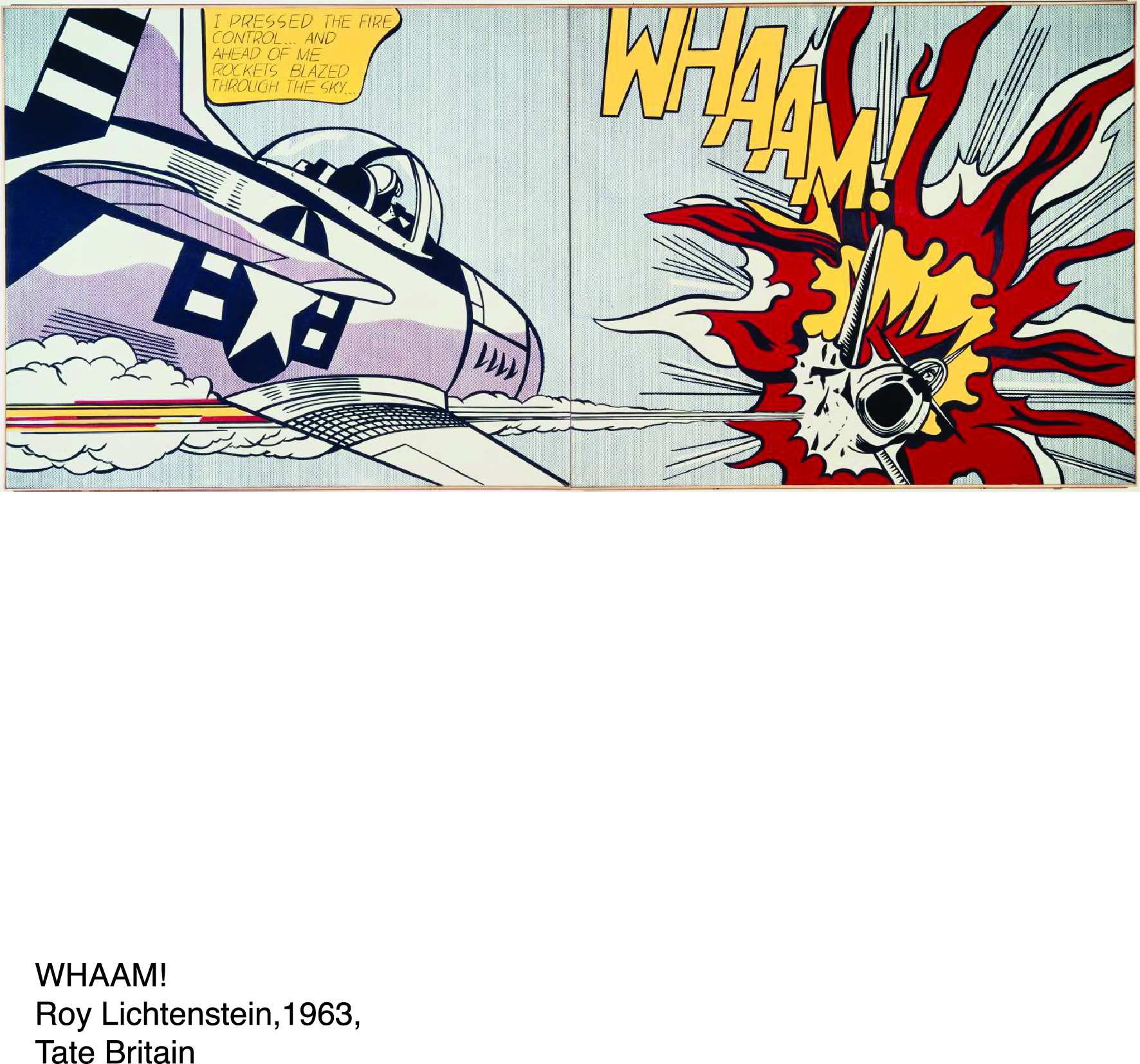
In April 1998 the Richard Gray gallery in Chicago held an exhibition of his works and James Yood wrote an almost epilogue to the critics of Lichtenstein works in the last years: “Going on the evidence of the last drawings and sculptures, it’s unlikely that anyone is going to propose a revolutionary late style for Roy Lichtenstein…(this works) confirm Lichtenstein’s lifelong strategy of pursuing the revelatory possibilities within a thoughtful and engaged equanimity.”
Looking and criticizing Lichtenstein from a distance of almost two decades since his death has the unfair lack of historical perspective, Too close to the object, too involved. The decantation that comes with time is still not here.
Nevertheless, it is legitimate to analyze your own generation, or close generations. Mankind always does it…

No artist is absolutely original and very few pretend to be so. In Lichtenstein case, he tried to develop, through his works, two or three main ideas. He presented before his public his version of modern society alienation, automatism and cold approach to life. The Baroque and Renaissance vanitas, the soap bubbles in Dutch family portraits, the perpetum mobile in “Dance to the Music of Time” by Poussin and some Leger moments of illumination are but a few examples of serious and critical mirrors that an artist erects in front of humanity. And of course I don’t think there is anything wrong either copying or citing other artists.
We are always able to trace Turner in the Impressionist, Japanism in Van Gogh, and for sure we can follow the footsteps of Braque in Picasso’s analytic Cubism:
“I’d rather use the term “dealing with” than “parody”. I’m sure there are certain aspects of irony, but I get really involved in making the painting that I’m working on…”
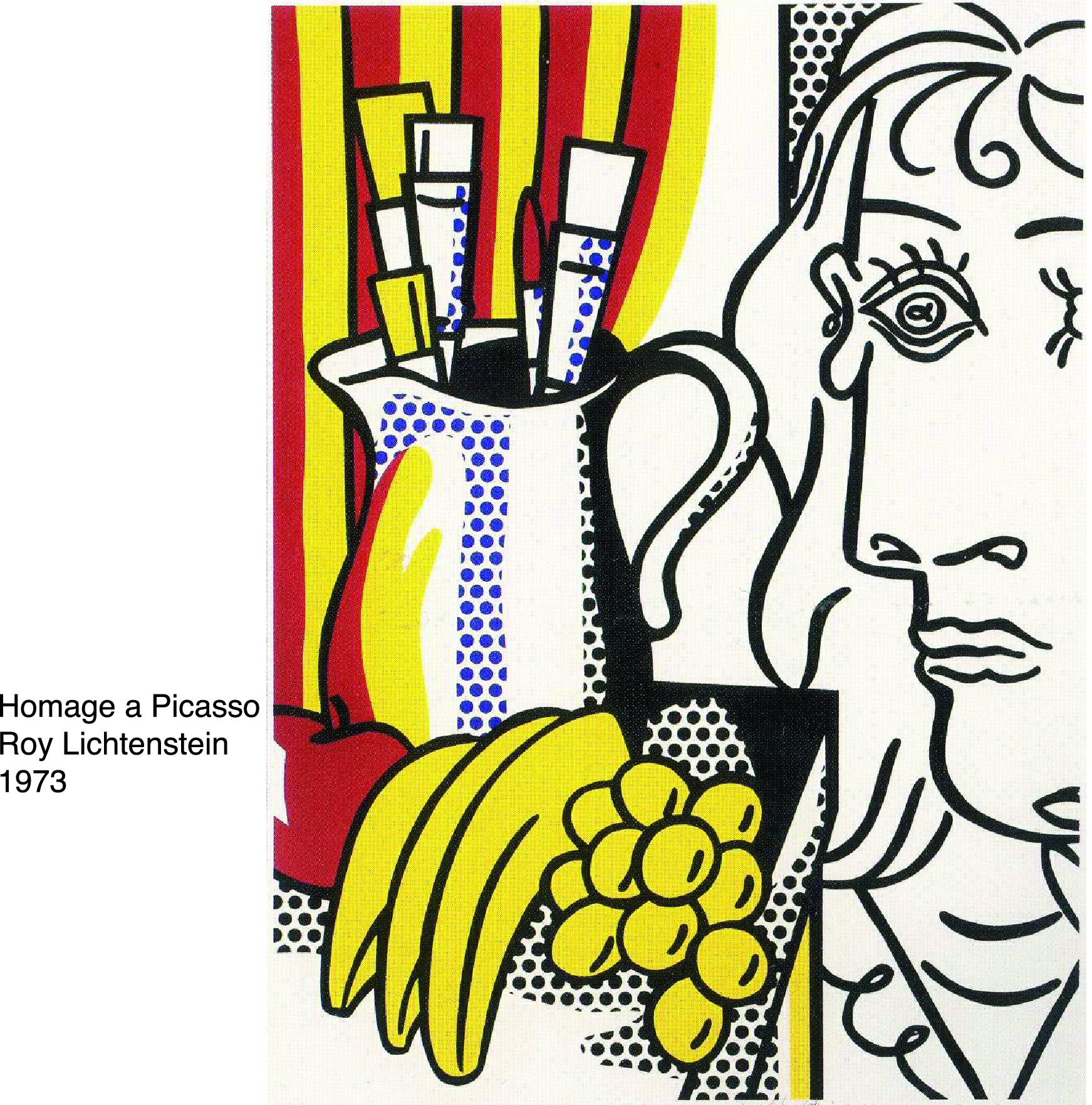
Roy Lichtenstein said those words in 1975, but if we try to analyse his pictures from 1978, “Stepping Out” at the Met, “Plus or Minus II”, 1989 canvases at the Tel Aviv Museum of Art (last picture in the book) we can discover that if he didn’t mean to make a parody… well, we are in trouble. Stepping out is more a Boterescan caricature than a real interpretation of Leger. Plus or Minus II is a burlesque Mondrian, trying to freeze a sublime development towards abstraction converting him in a ready-to-make-a-postcard mockery. And when his Picasso’s bull ascends the Tel Aviv Museum slope towards a Chagall violinist, nothing is more far away from the Guernica or bull fighting than this work.
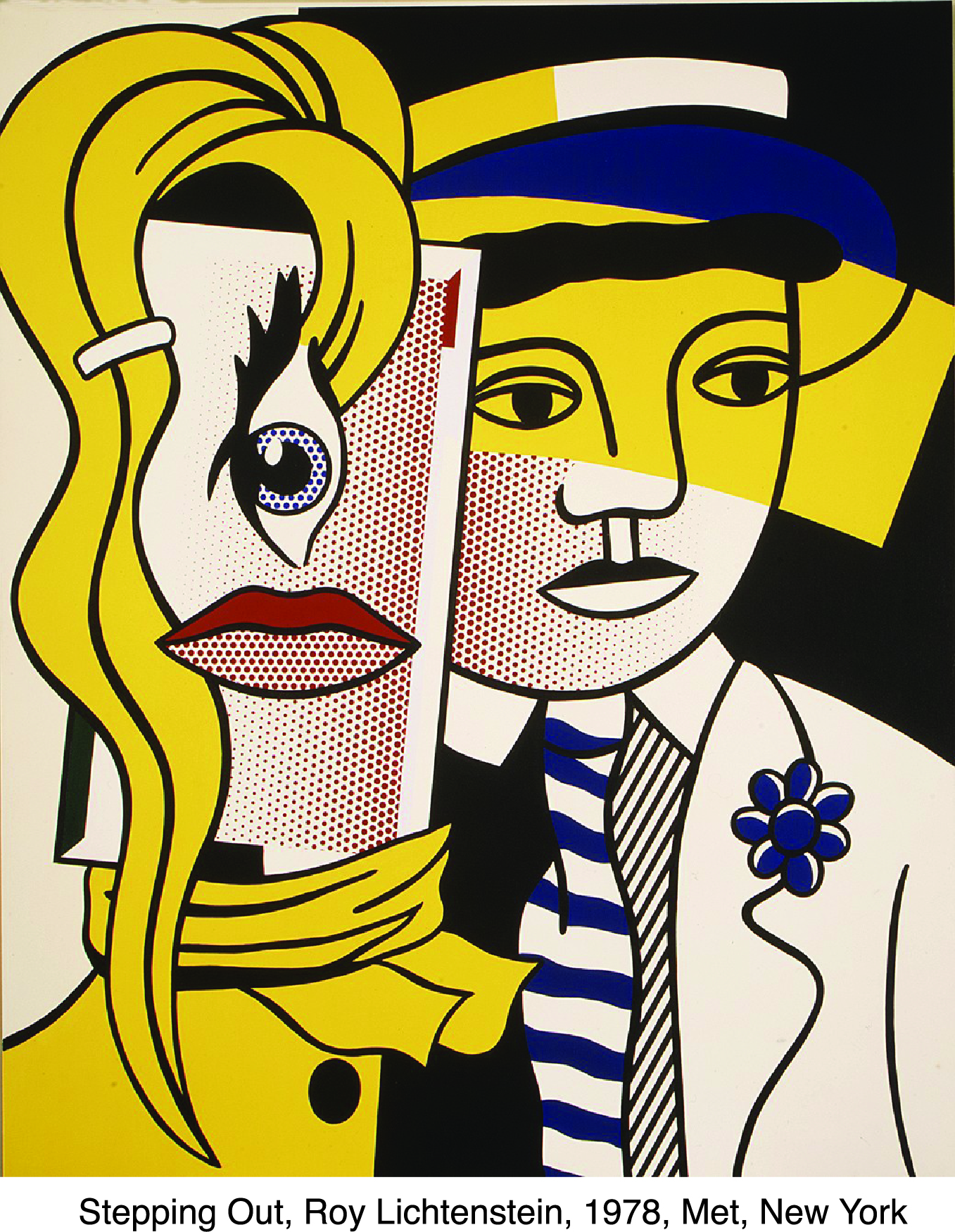
But Lichtenstein is a major blockbuster, a favorite of graphic designers and interior decorators. An artist that is so strong in the art dealing market and world museums that no question was put over his works since the tumultuous days in the early 1960’s, of Greenberg-Rosenberg. I’m not pretending here to be the devils advocate of “the devil’s advocate of art”, the framework I choose is to narrow for that. But I’m sure that Lichtenstein deserves a serious, unbiased criticism of his work. Less hallelujah words and more insights of the artist who developed one of the most instantly recognisable style since the beginnings of art history.
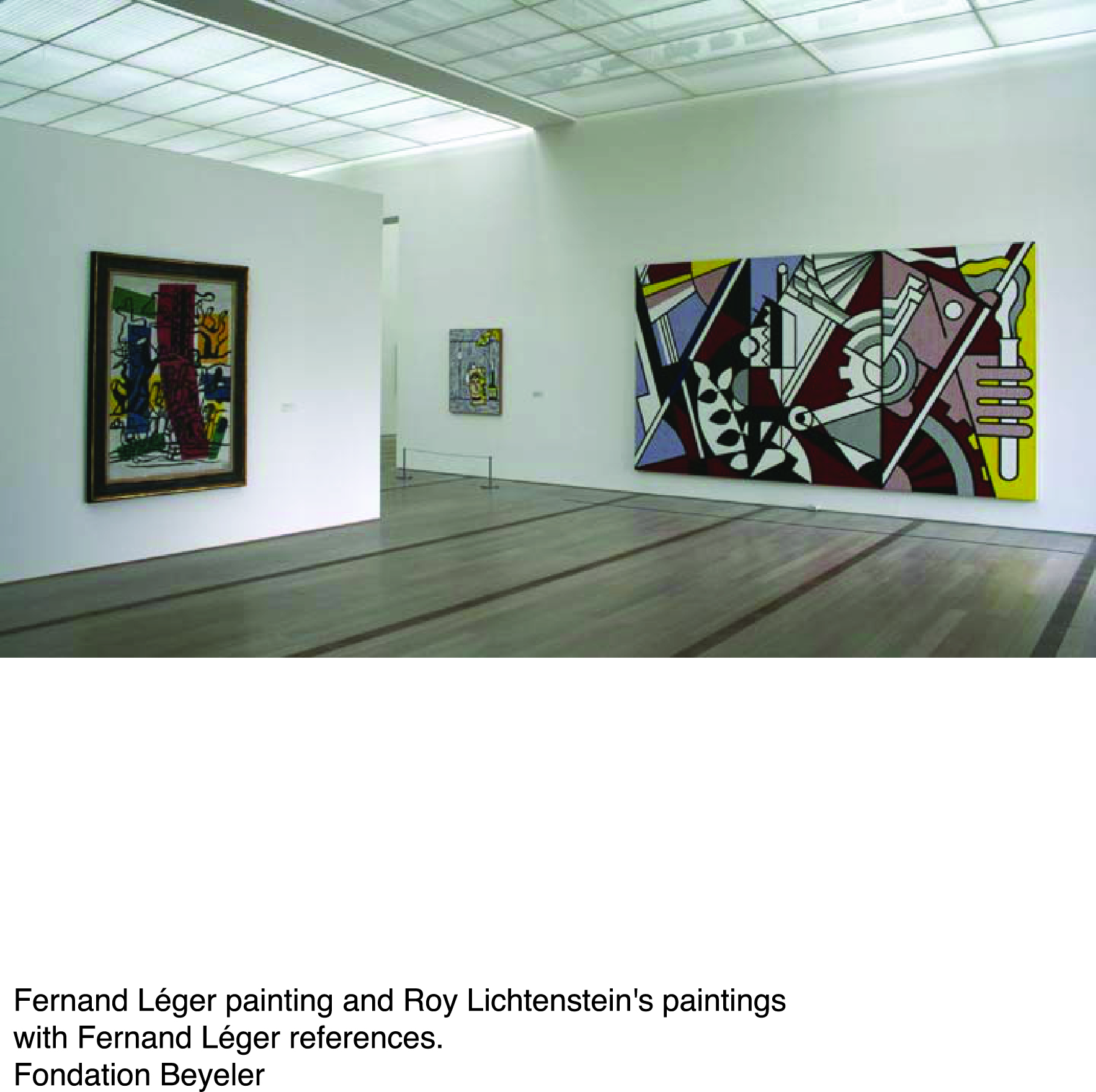
Conclusion: Relevant criticism can help to accentuate the different stages in Lichtenstein work, trying to deal with criticism aimed to a wide audience rather than to critics. There is nobody here to “blame”. And if there is any blame at all of Lichtenstein petrifaction too early in his carrier, is on us, critics, historians and teachers that focused our sights more in a decorative and part of the family” kind of art than in his work as a transcendent, critical and intellectual artist. Analysing Lichtenstein from a point of view situated in the thin line between two millenniums is sometimes trying to establish the relevance and duration of as artist during the next generations. And we always judge harshly and sometimes inadequately our contemporaries. The bankrupt of Rembrandt, the starvation of Soutine, the desperation of van Gogh are proof that our judgment can be changed or at least challenged by future generations.

Is a pop depiction of Apollo’s temple going to be a future example of 20th Century landscape painting, or one of the first symptoms of the modern decadent Empire fall?
“By connecting the artifact and its institutions to the bigger picture or
culture and society, the critic can, in effect, help readers better to
understand the process and implications of art, the importance and
problems of its institutions, and their relevance to their lives.”
Maurice Berger, The Crisis of Criticism, (New York, NY: The New York
Press, 1998)
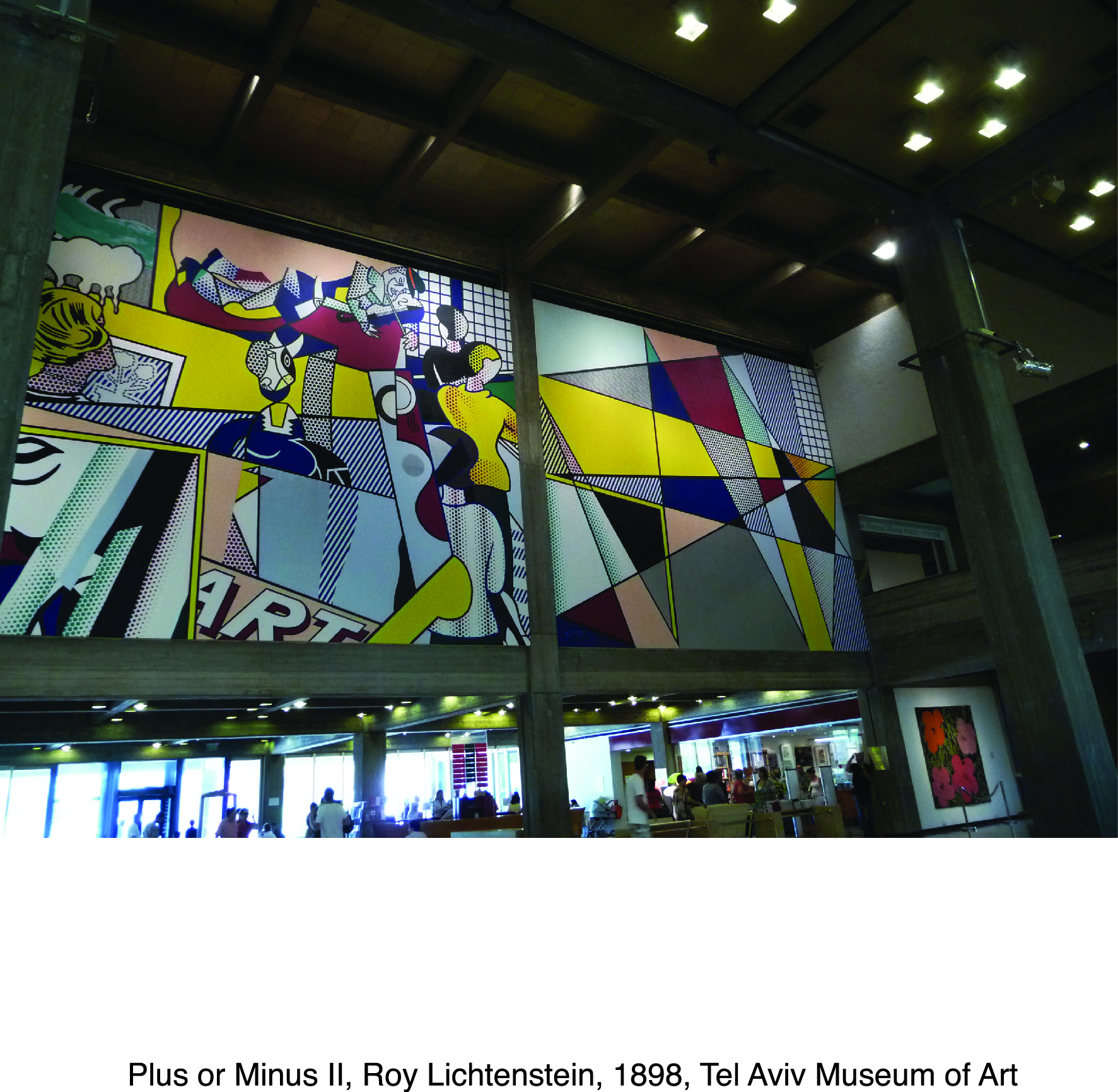

Published: Aug 8, 2015
Latest Revision: Aug 9, 2015
Ourboox Unique Identifier: OB-65102
Copyright © 2015








